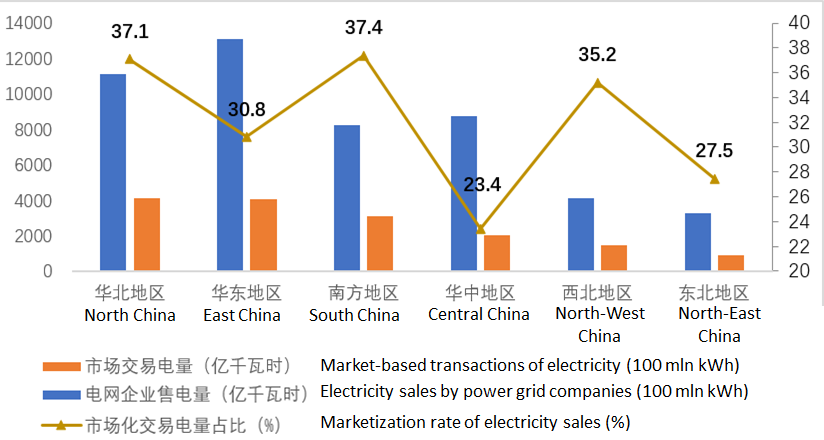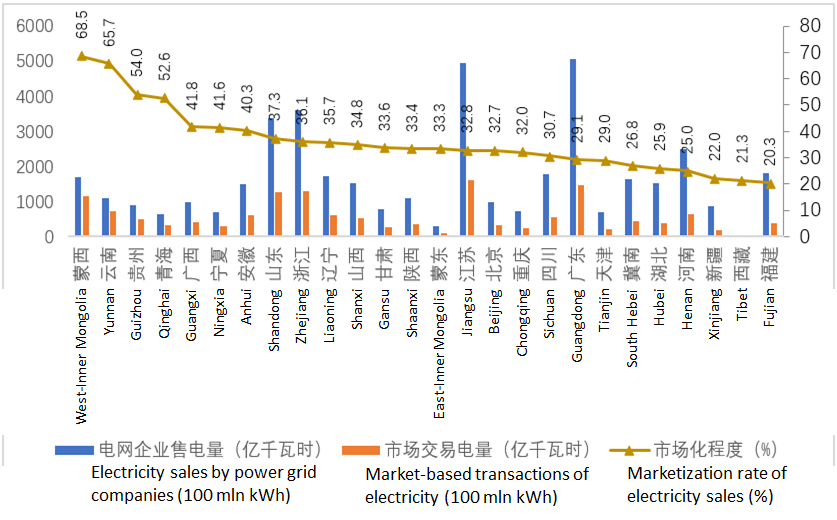All translations on this site are unofficial and provided for reference purpose only.
To view translations, select English under Step 1 (at the right of the screen). Not every item is (fully) translated. If you’re still seeing Chinese, you can use machine translation, under Step 2, to make sense of the rest.
Want to help translate? Switch to English under Step 1, and check ‘edit translation’ (more explanation in the FAQ). Even if you translate just a few lines, this is still very much appreciated! Remember to log in if you would like to be credited for your effort. If you’re unsure where to start translating, please see the list of Most wanted translations.
Summary analysis of national electricity market transaction data for 2017
Original title: 2017年度全国电力市场交易信息简要分析
Links: Source document (in Chinese) (link).
In 2017, total sales by the State Grid Corporation of China, China Southern Power Grid Corporation and the regional power grids owned by Inner Mongolia Power Company, together amounted to 4,866.1 TWh (source: China Electricity Council sector statistics). The total amount of market-based transactions was 1,632.4 TWh (source: CEC Power Trading Information Sharing Platform). Of this, the total amount of electricity traded within individual provincial markets was 1,340 billion TWh (including the transaction of power generation rights), accounting for 82% of nationwide market-based traded electricity. The total volume traded between provinces (including between regions) was 292.4 TWh (calculated as power at the receiving end; and excluding the volume of power agreed on in the West-to-East electricity transfer project)。National market-based transactions of electricity, as a share of the total sales volume of the national grid (that is, the marketization rate of electricity sales) reached 33.5%, and accounted for 25.9% of total national power consumption。
Looking at individual regions, the marketization rate of electricity sales is relatively high in the three regions of North China, South China and Northwest China, all exceeding 35%, having a leading role in the marketization of the national power market. The marketization rate of electricity sales is relatively low in Central China and Northeast China, which is related to relatively high share of hydropower in Central China , and the limited growth of electricity consumption in Northeast China 。Regarding the volume of market-based transactions, these are relatively high in the three regions of North China, East China, and South China, accounting for 25.1%, 24.6% and 18.8% of the national market-based electricity transactions, respectively. The three regions together account for close to 70% of the national volume of market-based electricity transactions。

Figure 1. Market-based transactions of electricity in 2017, by regional power grid
Looking at individual provinces, the top three provinces for total volume of market-based transactions of electricity were Jiangsu Province, at 161.8 TWh, Guangdong Province, at 147.1 TWh, and Zhejiang Province, at 130.2 TWh.。The top three provinces in terms of market-based trading for electricity imported from another province were Zhejiang Province, at 51.5 TWh, Shandong Province, at 40 TWh, Jiangsu Province, at 31.3 TWh。The top three provinces in terms the marketization rate of electricity sales were West-Inner Mongolia, Yunnan, and Guizhou, at 68.5%, 65.7%, and 54%, respectively。

Figure 2. Marketization rate of electricity sales in 2017, by province
In 2017, inter-provincial (including inter-regional) market-based trading was more active than the previous year, starting to result in more effective market-oriented allocation of energy resources。The proportion of electricity traded between provinces accounted for 17.9% of the national volume of market-based trading of electricity, with this proportion at 22.0% between the provinces under the State Grid, and at 8.7% between provinces under the South China Grid。When looking at the individual regions, the proportion of electricity traded between provinces, as a share of the total [regional-wide] volume of market-based trading of electricity was relatively high in North China and East China, at 24.3% and 24.9% respectively, with contributions mainly from Beijing, Shanghai, Tianjin, and Southern and Northern Hebei. The proportion of electricity traded between provinces, as a share of the total [province-wide] volume of market-based trading of electricity was more than 60% in the three directly-controlled municipalities. When adding Hunan, Qinghai, and Tibet, the proportion of electricity traded between provinces, as a share of the total [province-wide] volume of market-based trading of electricity was more than 30% in the above mentioned eight provinces and autonomous regions。
